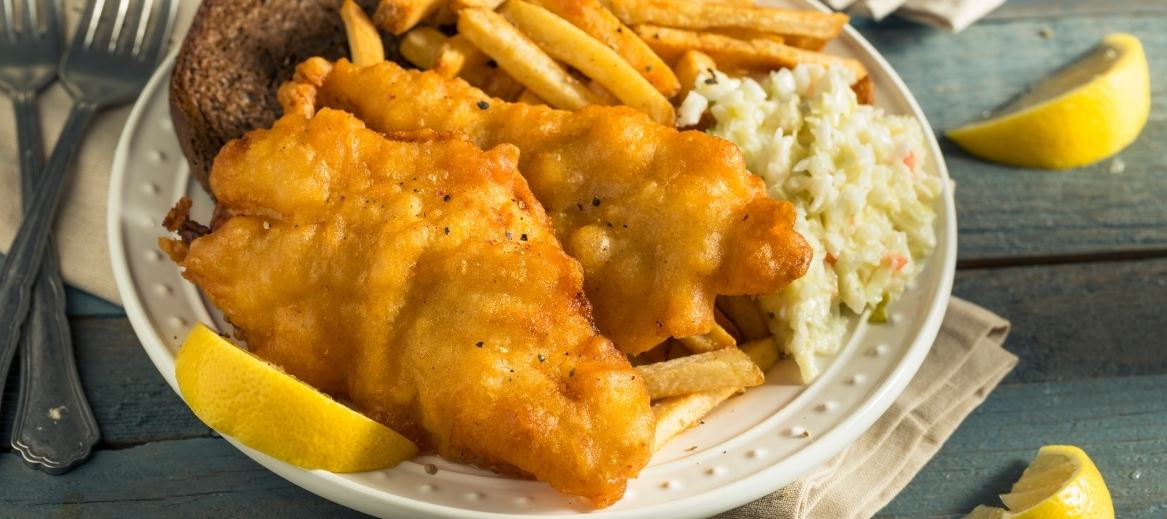It was during a camping trip with my family of nine people that I came up with the idea for this Beer Batter Fish Fry. We had freshwater big and smallmouth bass for dinner that night, and it was a true fish fry!
My cousins, particularly our local boy scout, raved about the batter, with many heads shaking in disbelief and hushed chewing to back up their claims (always a hallmark of an epic meal).
That camping trip’s meals, on the other hand, put all previous Scout camping meals to shame! For example, we set up the campfire such that we could cook a LEG OF LAMB at low heat.
Yeah. We made the trip there. As far as I’m concerned, this is simply the beginning of the story. Smoked Turkey Legs, my aunt’s favorite recipe, have also been eaten on numerous camping excursions with our cousins over the years.
But I’m getting ahead of myself…
For this beer batter fish fry, we put down a frankensteined mixture of preplanned ratios (we were hopeful about our possibilities for fish while packing food) and what we happened to have at the time on hand (namely Bisquick, the dregs of a bag of tortilla chips, and a handy bottle of beer).
Our recipe for beer battered fish fry was written on a smeared piece of coal and grease-smeared paper that was almost lost, but we were able to retrieve it from the family archives and recreate the dish’s finer points from memory.
This beer batter fish fry recipe can be used for any light fish, such as cod, halibut, etc., if you don’t happen to be fishing in the wilderness. The largemouth and smallmouth bass, on the other hand, go well with this recipe when cooked over an open fire.
For many Chinese families, it is customary to filet the largest of the catch and serve it with a beer batter fish fry at the campsite, rather than cooking the fish whole.
Fishing over an open flame and cooking potato wedges and tartar sauce at a campsite is a true labor of love. If you’ve got four or more folks, it’s worth the effort––and the memories––to try this.
Do it this way!
INGREDIENTS:
BATTER:
- 12 ounces of beer
- 1½ cups of flour, plus ¼ cup for dredging
- 1 tablespoon of vegetable oil
- 2/3 cup of crushed corn tortilla chips
- ½ teaspoon of baking powder
- 1/8 teaspoon of garlic powder
- ½ teaspoon of black pepper
- ¼ teaspoon of salt
POTATO WEDGES:
- 4 medium russet potatoes
- 1 teaspoon of black pepper
- 1 cup of flour
- 1 teaspoon of salt
- 1 tablespoon of paprika
TARTAR SAUCE:
- 1 tablespoon of lemon juice
- 1 medium finely diced dill pickle
- 1 finely diced shallot
- ½ cup of mayonnaise
- salt and pepper
INSTRUCTIONS:
- To begin, build a fire and warm a cast-iron pot on the grate over the fire. Heat up time for the oil is considerable. The temperature of the oil should be between 350 and 375 degrees Fahrenheit. Drop a potato slice into the oil and listen for it to sizzle to determine the oil’s temperature. If it doesn’t, check the temperature using a kitchen thermometer.
- Prepare your potatoes in advance of making the potato wedges. After soaking, use a kitchen towel to pat the surface dry. The flour, paprika, black pepper, and salt go into a separate basin. Toss in the potatoes until they are well-coated.
- After the potato wedges have been fried for around 10 to 11 minutes, they can be served. Use paper towels or a paper plate to transfer the food. When ready to serve, reheat the wedges for 1 to 2 minutes if desired for extra crispiness.
- Make your tartar sauce while the potatoes are baking. Toss the mayonnaise and lemon juice in a bowl with a pinch of salt and freshly ground black pepper. Wait to serve till you’re hungry!
- In a medium-sized basin, combine the dry ingredients for the fish batter. Stir in the oil and beer until well-combined before serving. Fold in the finely crushed white or yellow corn tortilla chips next, and let the batter sit for 20 minutes before using it again.
- Take care to keep the oil at a high temperature when you remove the potatoes from the pan. A sturdy bed of hot coals, or a portable gas burner, is necessary to ensure that you can cook from beginning to end.
- Use paper towels or a strainer to remove excess moisture from the fish fillets before cooking. The final 1/4 cup of flour should be lightly dredged over them. Then, using a fork, dip one end of each filet into the batter, allowing the excess to drip back into the bowl.
- Slowly lower the lower half of the fillet into the oil, swishing it a few times to partially fry it, then lower the rest of the fillet in one steady motion. That way, when you add the fish, you won’t have to worry about it sticking to the pan. In frying, the most important thing is not to be scared of the hot oil. It’s risky to drop the fish in with a splash, so go slowly and steadily.
- Since the first batch cools the oil immediately, you want the frying temperature to start at 375F. A moist piece of fish will be served if the temperature does not dip below 350F. The batter can burn if it’s heated any higher. Aim for 4 to 5 minutes of frying time for each side, but be sure to turn the fish often throughout that time. Golden brown and crispy batter is a good proxy.
- Serve the fried fish with potato wedges and tartar sauce on the side on a paper towel-lined platter. For the best camping food ever, this is it.
